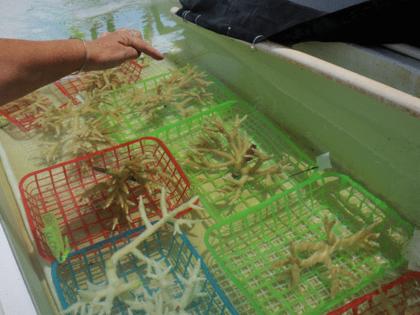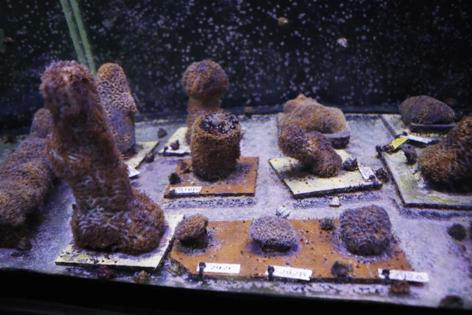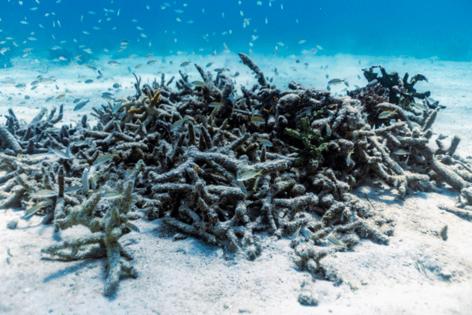Two more Florida corals are 'functionally extinct' after 2023 heatwave
Published in News & Features
MIAMI — The marine heatwave that gripped Florida in 2023 was hotter than anything Florida has seen in 150 years, and claimed at least two victims — species of corals now marked "functionally extinct" from Florida’s reefs.
That finding comes from a newly published scientific paper that reads more like an obituary for two of the most visible and important coral species on Florida’s reefs: elkhorn and staghorn corals. In 2023, the ocean was warmer than it had ever been. When corals spend too long in hot water, they spit out the algae that live within their bodies, providing them food and shade.
Without them, corals are ghostly white and bleached. If they stay bleached for too long, they starve and sunburn to death over a few weeks. But in 2023, scientists saw something new for Florida. The water got so hot, so fast that corals cooked to death in a matter of days.
The paper, published Thursday in the journal Science, was co-authored by nearly 50 Florida coral reef scientists who painstakingly surveyed Florida’s reefs from Broward County to the Dry Tortugas to tally up the damage from the historic heatwave two years ago, the ninth major bleaching event in the region.
The results were dramatic. In the Dry Tortugas and Florida Keys, 97.8 to 100% of those branching coral colonies died, the scientists found. The death toll was less in the slightly cooler waters off the coast of Miami-Dade and Broward — more like 38% of colonies died.
The numbers are harsh. But the diver’s eye view was even more dramatic, said one of the surveyor divers and co-authors, Richard Karp, a postdoctoral research associate at the University of Miami’s Cooperative Institute of Marine and Atmospheric Sciences with NOAA’s coral program.
Even from a boat, the gleaming white of bleached and dead corals glowed from beneath the surface. It was “heartbreaking,” Karp said.
A death blow for three coral species
Branching corals had been on the decline for decades. About 80% of the population died since the 1980s, mostly due to disease. The marine heat wave was just the final death blow.
Scientists found that enough of those species of corals died that they are now “functionally extinct,” a non-exact term that means there aren’t enough left to keep reproducing naturally on their own.
“The corals that are remaining on the reef, even though there are some, are no longer serving the function that they typically do. They’re not really able to repopulate,” Karp said.
This is the third such species that has earned this label since 2020, when scientists declared the pillar coral functionally extinct. A new paper published earlier this month in the journal Frontiers found that there are only 23 pillar corals left on Florida’s reef — most with live tissue smaller than a golf ball.
The survivors are so few and far between that they cannot make babies, said lead study author Karen Neely, a research scientist focused on corals at Nova Southeastern University. But pillar corals can live for hundreds of years, so the road to full extinction isn’t necessarily short.
“It could take one year, or hundreds of years, for that to happen. But without any new baby pillar corals being made in the system, there is only one end point for the species in Florida without humans intervening via restoration,” she said.
Unlike the branching corals, which were victims of water that at one point reached hot tub temperatures, pillar coral’s killer was mostly a pernicious and little understood coral disease, story coral tissue loss disease, although extreme heat did claim some.
However, Neely said, there’s a common takeaway from both stories of functionally extinct corals. In both cases, as the danger was spreading through the waters of the Florida reefs, scientists were busily yanking surviving corals out of the water and saving them in aquariums across the state.
“Those corals were dying as we were pulling them out of the water. If we had not rescued them, we would not have any left in Florida,” she said.
In the case of pillar corals, the Florida Aquarium was able to make some of those corals spawn in just six years, offering a ray of hope that the species will live on in some form.
Karp said the flat-out scramble to scoop branching corals from Florida’s tepid waters in the summer of 2023 was “absolutely worth it.”
“This really does show and help to quantify that all of these evacuation efforts we were doing in 2023, it wasn’t a joke. It was very, very bad and very, very necessary,” he said.
And while naturally conceived elkhorn and staghorn coral may soon be a thing of the past in Florida, reef restoration groups will keep breeding and replanting them. Both because they’re so easy and fast to grow and because they fill a role nothing else does on Florida reefs.
In the paper, scientists explained that these corals have been a mainstay on reefs worldwide for 250,000 to 500,000 years.
Of course, continuing to replant a species that has proven it can’t take the heat does risk a similar sight to 2023 — metal nursery trees covered entirely in ivory clumps of dead, baby coral.
When water temperatures spike, the state of Florida warns replanting groups to pause their efforts and keep those tender babies out of the water. It happened at least once this summer, before a tropical storm washed through and cooled down the waters surrounding the reef.
And scientists say, climate change is likely to keep cranking up the temperature of the world’s oceans. Corals could be some of the first victims of the warming world.
“Half of the Atlantic Ocean’s reef-building coral species face a risk of extinction due to ocean warming and other threats in the coming two decades,” scientists wrote in the new, branching coral paper. “Climate projections predict that annual severe bleaching will occur around 2040, whereas in situ warming trends suggest that frequent bleaching episodes will begin sooner, perhaps as early as this decade.”
This summer, scientists at NSU found that soft corals in Broward County — whose cooler, more northern waters were a haven for branching coral in 2023 — experienced a “rare” and “concerning” bleaching event.
In one surveyed area, 95% of a cylindrical-looking branching coral called the “corky sea finger” were bleached.
©2025 Miami Herald. Visit miamiherald.com. Distributed by Tribune Content Agency, LLC.












Comments